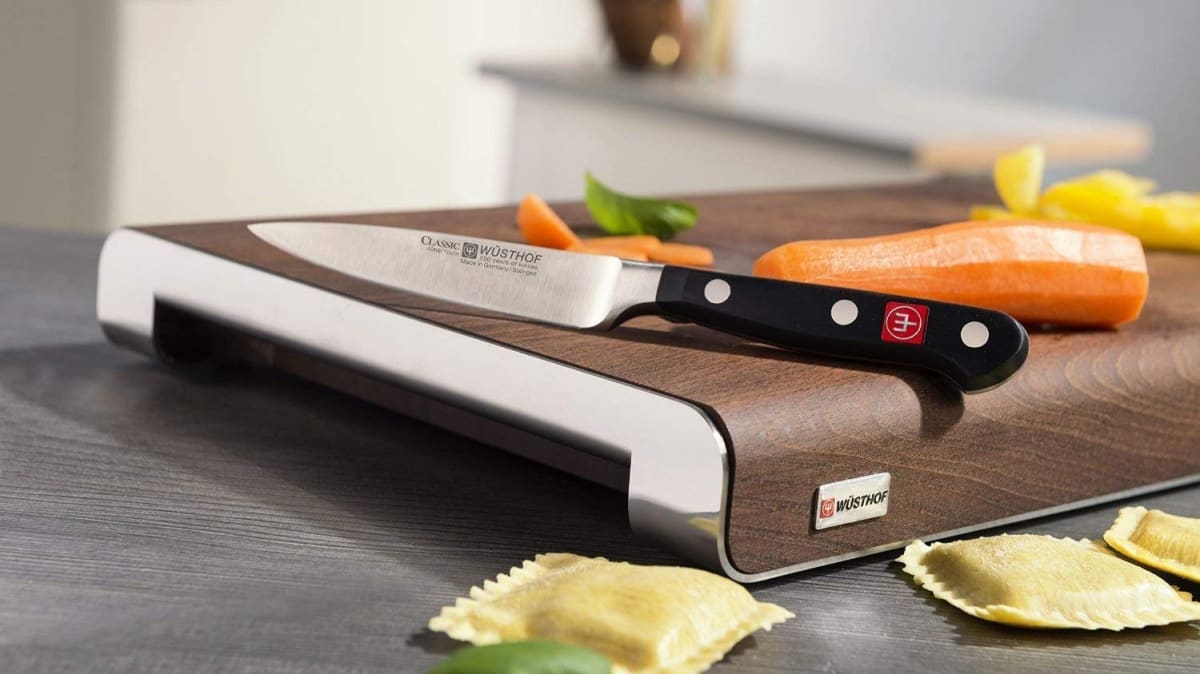A paring knife is a small, sharp knife that is used to peel and core fruits and vegetables. It can also be used to cut meat and fish. Paring knives are available in different sizes, but the most common size is three inches long.
A paring knife is a versatile tool that every home cook should have in their kitchen. Though small in size, a paring knife can be used for a variety of tasks, from peeling and slicing fruits and vegetables to removing the seeds from a jalapeño pepper.
In addition to being an essential tool for prepping fruits and vegetables, a paring knife can also be used for mincing garlic or ginger, slicing cheese, or cutting small pieces of meat.
Basically, if you need to cut something that is too small or delicate for a chef’s knife, reach for your trusty paring knife instead.
While there are many different types and styles of paring knives on the market, they all serve the same purpose – to make cooking easier and more efficient. So whether you choose a traditional straight-edged blade or a serrated option with a pointed tip, make sure you add a paring knife to your kitchen essentials list!
Utility Knife Uses
A utility knife is a versatile tool that can be used for a variety of purposes. Here are just a few of the ways you can put this handy tool to use:
1. Opening boxes: A utility knife is the perfect tool for opening up cardboard boxes.
The sharp blade easily cuts through tape and cardboard, making box-opening a breeze.
2. Cutting rope or twine: Have some rope or twine that needs to be cut? A utility knife can handle that task with ease.
Just be careful not to cut yourself in the process!
3. Stripping wire: If you need to strip the insulation off of electrical wires, a utility knife is the way to go. The sharp blade quickly and cleanly removes the insulation without damaging the wire underneath.
4. Carving wood: Utility knives can also be used for carving wood. This can come in handy if you need to make a quick repair or want to create something decorative out of a piece of wood. Just be sure not to apply too much pressure or you could end up breaking the blade.
5. Scraping paint: Are you working on a home improvement project that involves painting? A utility knife can help with that as well! Use it to scrape away old paint from surfaces before applying new paint .
Serrated Knife Uses
A serrated knife is a great tool to have in your kitchen. Here are some of the most common uses for a serrated knife:
1. Cutting bread – A serrated knife is the perfect tool for slicing through fresh bread.
The sharp, teeth-like edges make it easy to get a clean cut without squishing the bread.
2. Slicing tomatoes – Tomatoes can be tricky to slice with a regular kitchen knife. A serrated knife will glide through them effortlessly, leaving you with beautiful, even slices every time.
3. Carving meat – A serrated knife is also ideal for carving meat off the bone. The saw-like action of the blade makes it easy to get through tough meat without tearing it apart.
4. chopping herbs – If you need finely chopped herbs for your next meal, reach for a serrated knife.
The small teeth on the blade make quick work of delicate herbs like parsley and chives.
Chef Knife Uses
A chef knife is a versatile kitchen tool that can be used for a variety of tasks, from chopping vegetables to slicing meat. Here are some of the most common uses for a chef knife:
Chopping vegetables: A chef knife is the perfect tool for chopping vegetables like onions, carrots, and celery.
The sharp blade makes it easy to chop through tough veggies, and the wide blade gives you plenty of surface area to work with.
Slicing meat: Whether you’re cutting steak into thin strips or carving a roast chicken, a chef knife is up to the task. The sharp blade will make quick work of any type of meat, and the wide blade will give you a nice, even slice.
Boning chicken: If you need to remove the bones from a chicken breast or other piece of poultry, a chef knife is the ideal tool. The sharp blade will make it easy to cut through bone, and the wide blade will give you plenty of room to work.
Butchering fish: If you’re lucky enough to catch your own fish, you can use a chef knife to clean and fillet them.
The sharp blade will make quick work of scales and bones, while the wide blade will give you plenty of room to work with.
Boning Knife Uses
A boning knife is a versatile kitchen tool that can be used for a variety of tasks, from trimming meat to filleting fish. But what exactly is a boning knife and how do you use one?
A boning knife is a sharp, narrow blade that is designed for precision cutting.
The blade is usually between 2-6 inches long and has a pointed tip. This type of knife is also known as a filet knife or utility knife.
Boning knives are most commonly used to remove the bone from meat, poultry, and fish.
However, they can also be used to trim fat and sinew from meat or to cut up vegetables.
When using a boning knife, it’s important to hold the blade correctly. Grip the handle with your whole hand and position your index finger along the top of the blade (i.e., not on the side).
This will give you more control over the blade and help prevent accidents.
Start by slicing into the meat alongside the bone you want to remove. Then, use the tip of the blade to gently pry the bone away from the flesh.
Finally, use a sawing motion to free the bone completely. Once you’ve removed all bones, you can then proceed to trim any excess fat or sinew before cooking or serving your food.
Bread Knife Uses
A bread knife is a type of kitchen knife with a serrated blade that is used for slicing bread. The serrated edge allows the bread knife to easily slice through the crust of a loaf of bread without crushing the soft interior. Bread knives are available in different sizes and shapes, but most have a long, narrow blade that tapers to a point.
Bread knives can be used for more than just slicing bread; they can also be used for cutting cakes, pastries, and other baked goods. In addition, bread knives can be used to easily remove the skin from fruits and vegetables such as tomatoes and cucumbers.
French Knife Uses
A French knife is a type of pocketknife that is often used as a utility knife. It is characterized by its small size and lack of a guard. The blade is typically less than three inches long, and the handle is generally made from wood or bone.
French knives are often used for tasks such as carving, whittling, and opening packages. They are also popular collectibles due to their wide range of designs and historic significance.
Cleaver Knife Uses
A cleaver knife is a large, heavy knife that is typically used to chop meat. However, this versatile kitchen tool can also be used for a variety of other tasks, such as mincing garlic, slicing vegetables, and even breaking through bone. If you are looking for a multipurpose kitchen knife that can handle all of your chopping needs, then a cleaver knife is the way to go.
Santoku Knife Uses
A Santoku knife is a Japanese-style all-purpose kitchen knife. It is similar to a Western chef’s knife, but has a shorter blade and is lighter in weight. The word “Santoku” means “three virtues” or “three uses”, referring to the three tasks that this type of knife is designed for: slicing, dicing, and mincing.
This versatile knife can be used for everything from chopping vegetables to slicing meat. It is also a great choice for those who are new to cooking with Japanese knives, as it is relatively easy to use and maintain. With proper care, a Santoku knife can last for many years.
If you are looking for an all-purpose kitchen knife that can handle just about anything, then a Santoku might be the right choice for you!

Credit: www.reviewed.com
What is a Paring Knife Used For?
A paring knife is a small, sharp knife that is used for various tasks in the kitchen, including peeling and slicing fruits and vegetables. It is also useful for cutting small pieces of meat and fish, as well as making intricate garnishes. A paring knife typically has a blade that is 3-4 inches long and is designed to be held in the hand like a pencil.
Can You Use a Paring Knife to Cut Meat?
A paring knife is a small, pointed knife that is ideal for peeling and slicing fruits and vegetables. It can also be used to remove the seeds from a lemon or lime. While a paring knife is not typically used to cut meat, it can be done in a pinch if you don’t have a larger, more appropriate knife on hand.
When cutting meat with a paring knife, it’s important to use a sawing motion rather than trying to chop through the meat. This will help prevent the blade from slipping and potentially injuring you. It’s also important to use extra caution when cutting tougher meats like steak or pork chops, as they may require more pressure to cut through.
If you’re not comfortable using a paring knife to cut meat, it’s always best to err on the side of caution and use a different type of knife instead.
Learn About Paring Knife – What Is a Paring Knife?
Conclusion
Paring knives are small, versatile knives that are perfect for a variety of tasks in the kitchen. From peeling and slicing fruit and vegetables to trimming meat and fish, paring knives can be used for a variety of tasks.
Paring knives typically have a blade that is 3-4 inches long, making them the perfect size for maneuvering around small fruits and vegetables.
The sharp, pointed tip of the paring knife also makes it ideal for precision work like removing the core from an apple or carving out intricate designs in fruits and vegetables.
While paring knives are most commonly used in the kitchen, they can also be used for other tasks around the home such as opening letters and packages or even cutting rope or twine.
